Banh Dau Xanh, a delightful mung bean cake, is a treasured Vietnamese delicacy. Are you curious about what makes this sweet treat so special? SIXT.VN is here to unravel the mystery behind this iconic confection, guiding you through the essential components that create its unique flavor and texture. Whether you’re a foodie exploring Vietnamese cuisine or planning your next culinary adventure, discover the secrets of Banh Dau Xanh and how SIXT.VN can enhance your travel experience. Let’s delve into the ingredients and explore related aspects such as its cultural significance, preparation methods, and where to find the best Banh Dau Xanh in Vietnam, including tips for travelers.
1. What Is Banh Dau Xanh?
Banh Dau Xanh is a traditional Vietnamese mung bean cake, celebrated for its sweet flavor and melt-in-your-mouth texture. It’s a popular treat, often enjoyed with tea, and is a symbol of Vietnamese culinary heritage. It is commonly offered during celebrations and festivals, showing its importance in Vietnamese culture.
1.1. A Brief History and Cultural Significance
Originating from Hai Duong province, Banh Dau Xanh has a rich history dating back to the early 20th century. According to historical researcher Tang Ba Hoanh, as told to Hai Duong Provincial Museum, the cake was initially made in small establishments and gained recognition at international expositions. Over time, it has become a cultural icon, representing the ingenuity and delicacy of Vietnamese cuisine. It’s not just a cake; it’s a piece of Vietnamese heritage, often shared among friends and family.
1.2. Why Banh Dau Xanh Is Popular Among Tourists
Banh Dau Xanh’s popularity with tourists stems from its unique taste and cultural significance. Its small, cube-like shape and sweet flavor make it an accessible and enjoyable treat for international palates. Additionally, it is a popular souvenir, embodying the essence of Vietnamese flavors in a convenient package. According to a survey by the Vietnam National Administration of Tourism in 2023, food tours and culinary experiences are among the top interests for tourists visiting Vietnam, and Banh Dau Xanh is often a highlight.
2. Core Ingredients of Banh Dau Xanh
The magic of Banh Dau Xanh lies in its simplicity. With just a handful of key ingredients, this cake offers a burst of flavor and a delicate texture that’s hard to resist. The basic ingredients include mung beans, sugar, vegetable oil, and grapefruit flower essence.
2.1. Mung Beans: The Heart of the Cake
Mung beans are the main ingredient, providing the cake’s distinctive flavor and texture. They are carefully selected, soaked, and steamed until tender. According to a study by the Institute of Food Technology in 2022, mung beans are rich in protein and fiber, making them a nutritious ingredient.
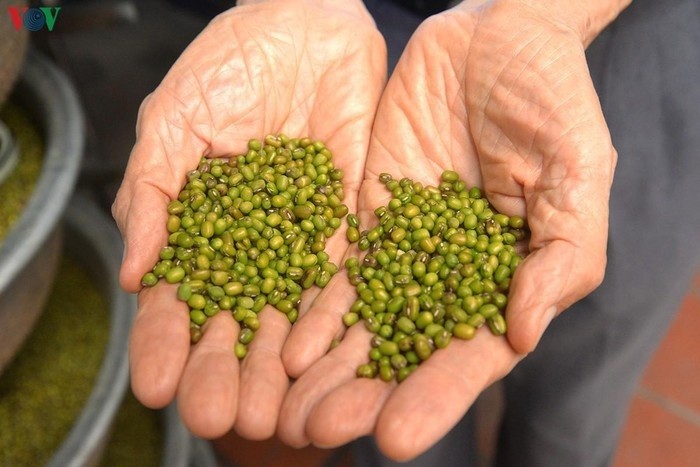 Banh Dau Xanh made with mung bean
Banh Dau Xanh made with mung bean
2.2. Sugar: Sweetening the Deal
Sugar is another essential ingredient, adding sweetness and contributing to the cake’s melt-in-your-mouth quality. The amount of sugar used can vary depending on the recipe and desired sweetness level. Different types of sugar can also influence the final taste and texture.
2.3. Vegetable Oil: Adding Richness
Vegetable oil is added to give the cake a rich and smooth texture. It helps bind the ingredients together and creates a pleasant mouthfeel. The type of oil used can affect the flavor profile, with some preferring neutral oils to let the other ingredients shine.
2.4. Grapefruit Flower Essence: A Touch of Aroma
Grapefruit flower essence, or vanilla extract, is used to add a delicate aroma and enhance the overall flavor of the cake. This ingredient is what sets Banh Dau Xanh apart, giving it a unique and refreshing twist. According to a 2021 article in the “Journal of Essential Oils Research,” grapefruit flower essence contains compounds that promote relaxation and well-being, adding a subtle therapeutic benefit to the treat.
3. Variations and Additional Ingredients
While the core ingredients remain consistent, variations of Banh Dau Xanh may include additional elements to enhance flavor and texture. These can include glutinous rice flour and other natural flavorings.
3.1. Glutinous Rice Flour: Enhancing Texture
Some recipes call for a small amount of glutinous rice flour to improve the cake’s texture, making it slightly chewier and more cohesive. This addition is particularly common in homemade versions, where achieving the perfect consistency is key.
3.2. Other Natural Flavorings
Depending on the region and personal preference, other natural flavorings may be added to Banh Dau Xanh. These can include lotus seed paste, pandan extract, or even a hint of green tea powder, offering a creative twist on the traditional recipe.
4. Traditional Preparation Methods
The traditional preparation of Banh Dau Xanh is a labor-intensive process, often passed down through generations. While modern techniques have streamlined some steps, the essence of the traditional method remains.
4.1. Step-by-Step Guide to Making Banh Dau Xanh
-
Prepare the Mung Beans: Soak the mung beans for several hours, then steam until they are soft and easily mashed.
-
Mash the Beans: Traditionally, the beans are mashed by hand using a mortar and pestle. Today, food processors are often used to save time and effort.
-
Cook the Mixture: Combine the mashed beans with sugar and vegetable oil in a pan. Cook over low heat, stirring continuously until the mixture thickens and forms a smooth paste.
-
Add Flavorings: Stir in the grapefruit flower essence or vanilla extract.
-
Mold the Cakes: Press the mixture into small molds, traditionally square or rectangular.
-
Cool and Serve: Allow the cakes to cool completely before serving. They are best enjoyed with hot tea.
4.2. The Role of Manual Labor in Traditional Recipes
Traditionally, Banh Dau Xanh production relied heavily on manual labor. From washing and steaming the beans to mashing and cooking the mixture, each step required careful attention and physical effort. This hands-on approach not only ensured the quality of the ingredients but also imbued the cake with a sense of tradition and craftsmanship.
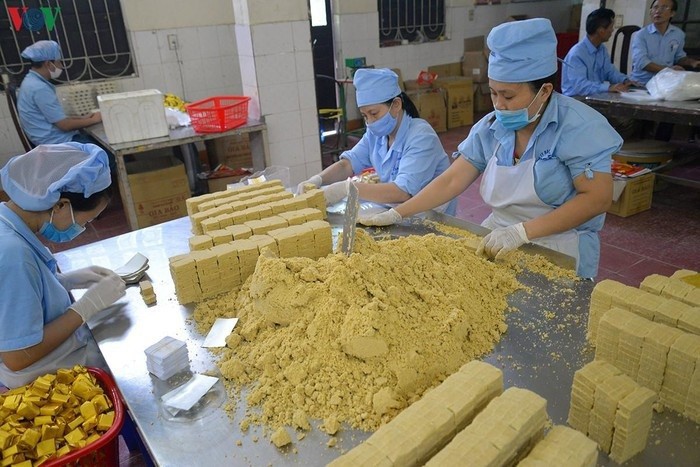 Banh Dau Xanh preparation
Banh Dau Xanh preparation
4.3. How Modern Techniques Have Influenced Production
Modern techniques have significantly transformed the production of Banh Dau Xanh. Machines now handle many of the labor-intensive tasks, such as steaming, mashing, and molding. This has increased production efficiency, allowing manufacturers to meet growing demand while maintaining consistent quality.
5. Nutritional Information and Health Benefits
While Banh Dau Xanh is primarily a sweet treat, it does offer some nutritional benefits, thanks to its main ingredient, mung beans.
5.1. Breakdown of Calories and Nutrients
A typical serving of Banh Dau Xanh (around 30g) contains approximately:
- Calories: 120-150
- Protein: 2-3g
- Fat: 5-7g
- Carbohydrates: 15-20g
- Fiber: 1-2g
5.2. Health Benefits of Mung Beans
Mung beans are a good source of protein, fiber, and essential minerals like iron and magnesium. According to a 2020 study published in the “Journal of Agricultural and Food Chemistry,” mung beans have antioxidant properties that can help protect against chronic diseases.
5.3. Considerations for Dietary Restrictions
Banh Dau Xanh is generally gluten-free but may not be suitable for individuals with diabetes due to its high sugar content. Those with nut allergies should also be cautious, as some variations may contain traces of nuts.
6. Where to Find the Best Banh Dau Xanh in Vietnam
While Banh Dau Xanh can be found throughout Vietnam, certain regions and brands are particularly renowned for their quality and taste.
6.1. Hai Duong Province: The Birthplace of Banh Dau Xanh
Hai Duong province is widely regarded as the home of Banh Dau Xanh. Here, you’ll find numerous local shops and manufacturers producing the cake using traditional methods. According to the Hai Duong Tourism Department, the province boasts over 50 brands of Banh Dau Xanh, each with its unique recipe and flavor profile.
6.2. Popular Brands and Shops
Some of the most popular Banh Dau Xanh brands in Vietnam include:
- Nguyen Huong: Known for its classic recipe and high-quality ingredients.
- Bao Minh: A trusted brand with a long history of producing Banh Dau Xanh.
- Huu Binh: Famous for its smooth texture and aromatic flavor.
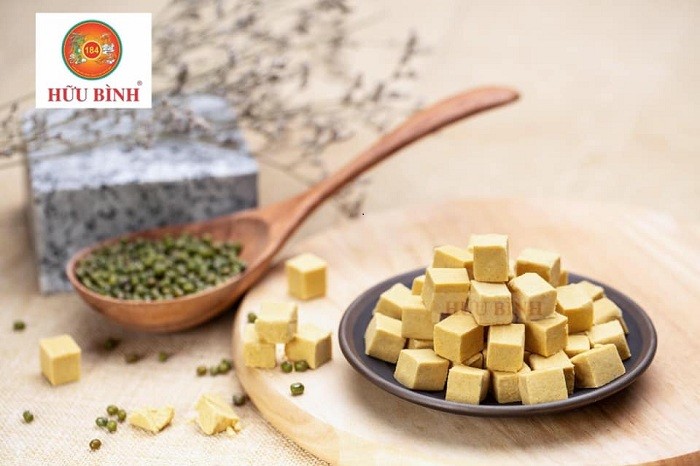 Banh Dau Xanh brand Huu Binh
Banh Dau Xanh brand Huu Binh
6.3. Tips for Buying Authentic Banh Dau Xanh
To ensure you’re getting authentic Banh Dau Xanh, look for reputable brands with clear packaging and ingredient lists. Check for a recent production date and avoid cakes that appear overly dry or discolored. Buying directly from local shops in Hai Duong province is often the best way to experience the freshest and most authentic Banh Dau Xanh.
7. Serving and Enjoying Banh Dau Xanh
Banh Dau Xanh is traditionally enjoyed with hot tea, but there are many other ways to savor this sweet treat.
7.1. Traditional Serving Suggestions
The classic way to enjoy Banh Dau Xanh is with a cup of hot green tea. The tea’s slightly bitter taste complements the cake’s sweetness, creating a harmonious balance of flavors. According to Vietnamese culinary traditions, this pairing is not just about taste but also about creating a moment of relaxation and contemplation.
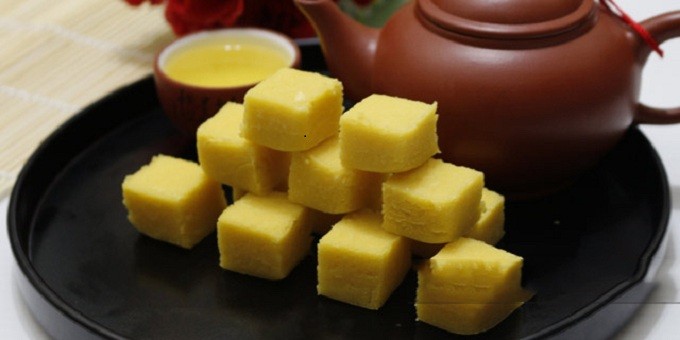 Banh Dau Xanh and tea
Banh Dau Xanh and tea
7.2. Creative Pairings and Modern Twists
For a modern twist, try pairing Banh Dau Xanh with coffee or herbal tea. You can also crumble it over ice cream or yogurt for a sweet and crunchy topping. Some chefs have even incorporated Banh Dau Xanh into desserts like parfaits and mousses, showcasing its versatility.
7.3. Banh Dau Xanh as a Gift or Souvenir
Banh Dau Xanh makes an excellent gift or souvenir, especially for those wanting to share a taste of Vietnamese culture with friends and family. Its small size and attractive packaging make it easy to transport, and its unique flavor is sure to impress. According to a 2022 survey by the Vietnam Tourism Marketing Agency, Banh Dau Xanh is among the top five most popular souvenirs purchased by tourists visiting Vietnam.
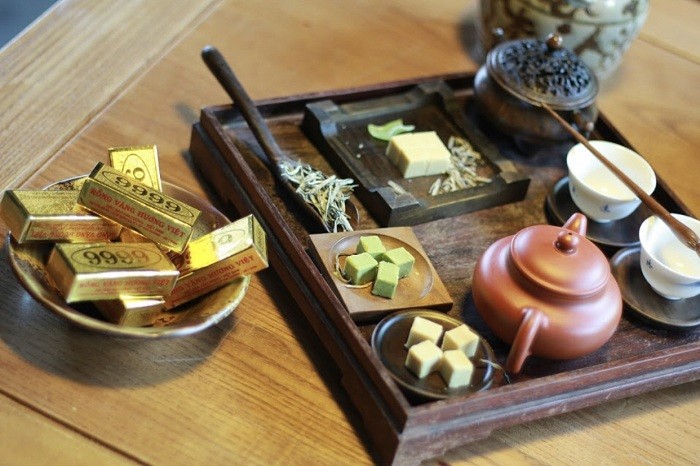 Banh Dau Xanh as gift
Banh Dau Xanh as gift
8. Cultural Significance in Vietnamese Festivals
Banh Dau Xanh is more than just a sweet treat; it holds significant cultural value, especially during Vietnamese festivals and celebrations.
8.1. Role in Tet (Lunar New Year)
During Tet, the Lunar New Year, Banh Dau Xanh is often placed on the family altar as an offering to ancestors. It symbolizes good luck and prosperity for the coming year. Pham Le Giang, a Vietnamese student in Leeds, UK, recalls that there is always a box of Banh Dau Xanh on the family’s altar during Tet, and sharing it with international friends brings back memories of home.
8.2. Use in Weddings and Other Celebrations
Banh Dau Xanh is also a popular treat at weddings and other celebrations, symbolizing sweetness and happiness. Its presence signifies a wish for a sweet and prosperous life for the celebrants.
8.3. Symbolism and Tradition
The cake’s simple ingredients and delicate flavor reflect the values of simplicity, harmony, and respect for tradition that are deeply ingrained in Vietnamese culture. Sharing Banh Dau Xanh is a way of sharing these values and connecting with loved ones.
9. Preserving and Storing Banh Dau Xanh
Proper storage is essential to maintaining the freshness and flavor of Banh Dau Xanh.
9.1. Best Storage Practices
Store Banh Dau Xanh in an airtight container at room temperature. Avoid exposing it to direct sunlight or excessive heat, as this can cause it to dry out or spoil.
9.2. Shelf Life and Expiry
Banh Dau Xanh typically has a shelf life of several weeks to a few months, depending on the ingredients and storage conditions. Check the packaging for the expiry date and consume before then for the best quality.
9.3. Tips for Keeping It Fresh Longer
To keep Banh Dau Xanh fresh longer, consider wrapping each piece individually in plastic wrap before storing it in an airtight container. This will help prevent it from drying out and maintain its flavor.
10. Exploring Banh Dau Xanh with SIXT.VN
For travelers planning a culinary adventure in Vietnam, SIXT.VN offers a range of services to enhance your experience, including opportunities to discover and enjoy authentic Banh Dau Xanh.
10.1. How SIXT.VN Can Enhance Your Culinary Travel Experience
SIXT.VN provides convenient transportation options, including airport transfers and car rentals, making it easy to explore different regions of Vietnam and sample local delicacies like Banh Dau Xanh. We also offer curated tour packages that include culinary experiences, allowing you to taste the best of Vietnamese cuisine.
10.2. Tour Packages Featuring Local Delicacies
Our tour packages often include visits to local markets and food stalls where you can sample authentic Banh Dau Xanh and other regional specialties. We also partner with local chefs and restaurants to offer exclusive culinary experiences, such as cooking classes and tasting menus.
10.3. Tips for Planning Your Culinary Trip to Vietnam
When planning your culinary trip to Vietnam, consider visiting during local festivals or events, where you can experience traditional foods and customs. Research local specialties in each region you plan to visit, and don’t be afraid to try street food – it’s often the most authentic and delicious. Finally, book your transportation and accommodations with SIXT.VN to ensure a seamless and enjoyable travel experience.
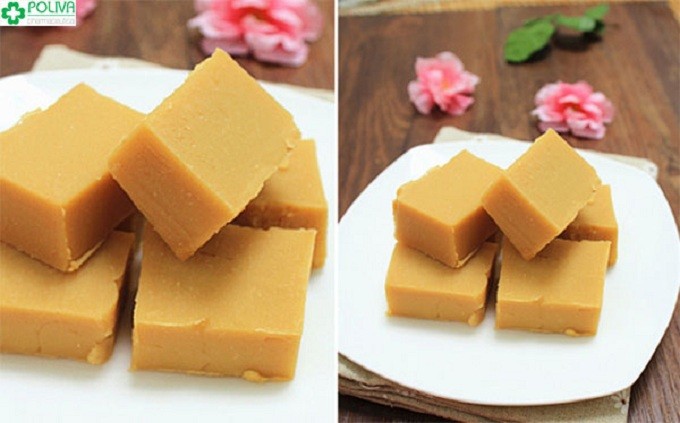 Beautiful Banh Dau Xanh arranged as flower
Beautiful Banh Dau Xanh arranged as flower
11. Banh Dau Xanh Recipe for Home Cooking
If you’re inspired to try making Banh Dau Xanh at home, here’s a simplified recipe to get you started.
11.1. Ingredients List
- 200g mung beans
- 150-200g sugar
- 1 tablespoon glutinous rice flour
- 2-3 tablespoons vegetable oil
- ½ tablespoon vanilla extract or grapefruit flower essence
11.2. Step-by-Step Cooking Instructions
-
Prepare the Beans: Soak the mung beans for a few hours and steam until tender.
-
Mash the Beans: Crush the beans and mix them with the sugar.
-
Cook the Mixture: Simmer the beans over medium heat for about 20 minutes.
-
Add Flour and Oil: Add the flour and oil mixture to the pot for another 10 minutes, then add the vanilla.
-
Cool and Mold: Allow the final product to cool to be seared and divided into small pieces.
-
Enjoy: Serve with tea and enjoy!
11.3. Tips for Perfecting Your Homemade Banh Dau Xanh
To achieve the perfect texture, make sure the mung beans are thoroughly cooked and mashed. Stir the mixture continuously while cooking to prevent it from sticking to the pan. Adjust the amount of sugar to your preference, and don’t be afraid to experiment with different flavorings.
 Raw ingredients for Banh Dau Xanh
Raw ingredients for Banh Dau Xanh
12. How Banh Dau Xanh Reflects Vietnamese Culture
Banh Dau Xanh is more than just a cake; it is a reflection of Vietnamese culture, embodying the values of simplicity, harmony, and tradition.
12.1. Simplicity in Ingredients and Preparation
The cake’s basic ingredients and straightforward preparation methods reflect the Vietnamese appreciation for simplicity. It is a reminder that the best things in life are often the simplest.
12.2. Harmony in Flavor and Texture
The harmonious blend of sweet, nutty, and aromatic flavors in Banh Dau Xanh represents the Vietnamese desire for balance and harmony in all aspects of life. The cake’s smooth, melt-in-your-mouth texture adds to this sense of balance, creating a satisfying and comforting treat.
12.3. Tradition and Heritage
Banh Dau Xanh is a link to Vietnam’s rich cultural heritage, passed down through generations. It is a symbol of the country’s culinary ingenuity and the enduring values of family, community, and tradition.
13. Sustainable Practices in Banh Dau Xanh Production
As consumers become more conscious of sustainability, some Banh Dau Xanh producers are adopting eco-friendly practices.
13.1. Eco-Friendly Sourcing of Ingredients
Some producers are sourcing their mung beans and other ingredients from local farmers who use sustainable agricultural practices. This not only reduces the environmental impact of production but also supports local communities.
13.2. Sustainable Packaging Options
Many brands are now using eco-friendly packaging materials, such as biodegradable paper and cardboard, to reduce waste. Some are even offering refillable containers for bulk purchases.
13.3. Reducing Waste in Production
Producers are also implementing measures to reduce waste in the production process, such as recycling food scraps and using energy-efficient equipment. These efforts help minimize the environmental footprint of Banh Dau Xanh production.
14. The Future of Banh Dau Xanh: Innovations and Trends
While Banh Dau Xanh remains rooted in tradition, there is room for innovation and adaptation to meet changing consumer preferences.
14.1. Modern Variations and Fusion Recipes
Some chefs are experimenting with modern variations of Banh Dau Xanh, incorporating new flavors and ingredients. These fusion recipes offer a fresh twist on the classic treat, appealing to a wider audience.
14.2. Catering to Health-Conscious Consumers
As health consciousness grows, some producers are offering healthier versions of Banh Dau Xanh with reduced sugar content and added nutrients. These options cater to consumers looking for a guilt-free indulgence.
14.3. Global Appeal and Export Markets
Banh Dau Xanh is gaining popularity in international markets, with exports increasing in recent years. Its unique flavor and cultural significance make it a sought-after treat among food lovers worldwide.
15. DIY Banh Dau Xanh: Tips and Tricks
Making Banh Dau Xanh at home can be a fun and rewarding experience. Here are some tips and tricks to help you create the perfect batch.
15.1. Selecting the Right Mung Beans
Choose high-quality mung beans that are fresh and free from impurities. Soaking them for at least 4 hours or overnight will help soften them and reduce cooking time.
15.2. Achieving the Perfect Texture
The key to achieving the perfect texture is to thoroughly mash the cooked mung beans until they are smooth and creamy. Using a food processor or blender can help achieve this consistency.
15.3. Flavor Enhancements and Variations
Don’t be afraid to experiment with different flavor enhancements and variations. Try adding a pinch of salt to balance the sweetness, or incorporate other natural flavorings like coconut milk or pandan extract.
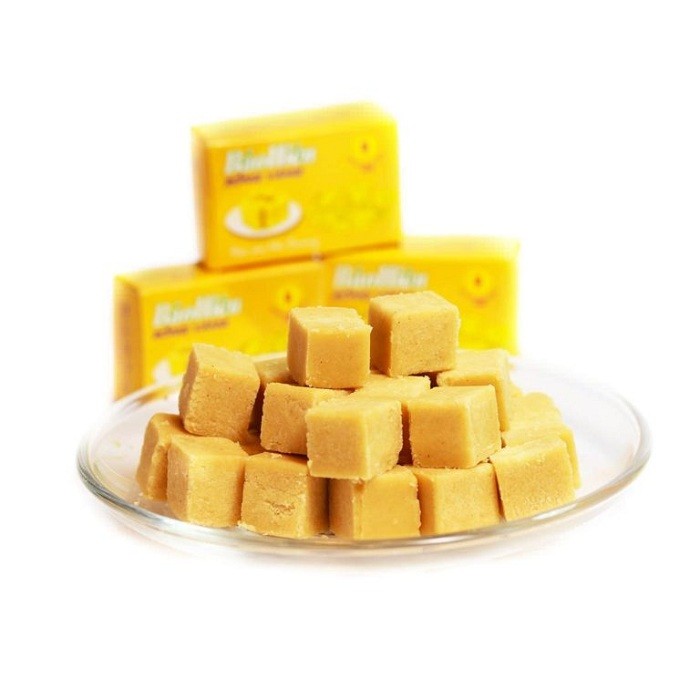 Finished Banh Dau Xanh
Finished Banh Dau Xanh
16. Banh Dau Xanh and Vietnamese Coffee Culture
While Banh Dau Xanh is traditionally paired with tea, it also complements Vietnamese coffee, offering a delightful contrast of flavors.
16.1. Pairing with Traditional Vietnamese Coffee
The strong, bold flavor of traditional Vietnamese coffee, brewed with a phin filter, pairs well with the sweetness of Banh Dau Xanh. The coffee’s slight bitterness cuts through the cake’s richness, creating a balanced and satisfying experience.
16.2. Modern Coffee Creations with Banh Dau Xanh
Some cafes are experimenting with modern coffee creations that incorporate Banh Dau Xanh, such as Banh Dau Xanh-flavored lattes and cappuccinos. These innovative drinks offer a unique and delicious way to enjoy the flavors of Vietnam.
16.3. Café Recommendations in Hanoi
In Hanoi, consider visiting these cafes to enjoy Banh Dau Xanh with Vietnamese coffee:
- Cafe Giang: Known for its egg coffee and traditional Vietnamese snacks. Address: 39 Nguyen Huu Huan, Hoan Kiem, Hanoi.
- The Note Coffee: A cozy cafe where you can write notes and enjoy a variety of coffee drinks and pastries. Address: 64 Luong Van Can, Hoan Kiem, Hanoi.
- Hanoi Social Club: A trendy spot with a relaxed atmosphere and a menu featuring both local and international dishes. Address: 6 Hoi Vu, Hoan Kiem, Hanoi.
17. Addressing Common Misconceptions About Banh Dau Xanh
Despite its popularity, there are some common misconceptions about Banh Dau Xanh that need to be addressed.
17.1. Is Banh Dau Xanh Only for Special Occasions?
While Banh Dau Xanh is often enjoyed during festivals and celebrations, it is also a popular everyday treat. It can be enjoyed any time of day, whether as a snack with tea or as a dessert after a meal.
17.2. Is Banh Dau Xanh Difficult to Make?
While traditional recipes can be labor-intensive, there are many simplified versions that are easy to make at home. With a few basic ingredients and simple steps, anyone can create their own batch of Banh Dau Xanh.
17.3. Is Banh Dau Xanh Unhealthy?
Like any sweet treat, Banh Dau Xanh should be consumed in moderation. However, it does offer some nutritional benefits thanks to its main ingredient, mung beans. Choosing versions with reduced sugar content and natural ingredients can also make it a healthier option.
18. Banh Dau Xanh in Vietnamese Literature and Art
Banh Dau Xanh has also found its way into Vietnamese literature and art, symbolizing cultural identity and traditional values.
18.1. References in Traditional Stories
Banh Dau Xanh often appears in traditional Vietnamese stories and poems, representing the simplicity and beauty of rural life. It is a symbol of home, family, and the enduring traditions of Vietnamese culture.
18.2. Depictions in Art and Photography
Artists and photographers often depict Banh Dau Xanh in their works, capturing its delicate beauty and cultural significance. These depictions help to preserve and promote Vietnamese culture, both at home and abroad.
18.3. Banh Dau Xanh as a Symbol of Vietnamese Identity
Overall, Banh Dau Xanh serves as a symbol of Vietnamese identity, representing the country’s rich culinary heritage and the values of simplicity, harmony, and tradition. It is a reminder of the beauty and resilience of Vietnamese culture.
19. Travelers’ Experiences: Banh Dau Xanh Moments
Hearing from fellow travelers can inspire your own culinary adventures. Here are some memorable Banh Dau Xanh moments shared by tourists who have visited Vietnam.
19.1. Memorable Encounters with Banh Dau Xanh
Many tourists recall their first taste of Banh Dau Xanh as a highlight of their trip to Vietnam. They often describe being captivated by its unique flavor and melt-in-your-mouth texture.
19.2. Personal Stories and Anecdotes
Some travelers share personal stories of discovering Banh Dau Xanh in local markets, learning to make it in cooking classes, or sharing it with friends and family back home. These anecdotes highlight the cake’s ability to connect people and create lasting memories.
19.3. How Banh Dau Xanh Enhanced Their Trip
Many travelers agree that experiencing Banh Dau Xanh added a special dimension to their trip to Vietnam, allowing them to connect with the local culture and traditions in a meaningful way.
20. Essential Vietnamese Phrases for Banh Dau Xanh Enthusiasts
Learning a few basic Vietnamese phrases can enhance your culinary experience and help you connect with locals.
20.1. Basic Phrases for Ordering and Asking About Banh Dau Xanh
- “Xin chào” (Hello)
- “Tôi muốn mua bánh đậu xanh” (I want to buy Banh Dau Xanh)
- “Bánh đậu xanh này có ngon không?” (Is this Banh Dau Xanh delicious?)
- “Bánh đậu xanh này làm từ gì?” (What is this Banh Dau Xanh made from?)
- “Cảm ơn” (Thank you)
20.2. Phrases for Expressing Appreciation
- “Ngon quá!” (So delicious!)
- “Tôi rất thích bánh đậu xanh” (I really like Banh Dau Xanh)
- “Đây là món ăn tuyệt vời” (This is a wonderful dish)
20.3. Tips for Pronunciation
Vietnamese pronunciation can be challenging for beginners, but don’t be afraid to try your best. Focus on getting the tones right, and practice with native speakers whenever possible. Online resources and language learning apps can also be helpful.
21. FAQ About Banh Dau Xanh
Let’s address some frequently asked questions about Banh Dau Xanh to help you understand more about this Vietnamese delicacy.
21.1. What are the main ingredients in Banh Dau Xanh?
The main ingredients in Banh Dau Xanh are mung beans, sugar, vegetable oil, and grapefruit flower essence or vanilla extract. These simple ingredients combine to create the cake’s unique flavor and texture.
21.2. Is Banh Dau Xanh gluten-free?
Yes, Banh Dau Xanh is generally gluten-free, as it does not contain wheat or other gluten-containing ingredients. However, it’s always a good idea to check the ingredient list to ensure there are no hidden sources of gluten.
21.3. How should Banh Dau Xanh be stored?
Banh Dau Xanh should be stored in an airtight container at room temperature, away from direct sunlight and excessive heat. This will help maintain its freshness and flavor.
21.4. What is the shelf life of Banh Dau Xanh?
Banh Dau Xanh typically has a shelf life of several weeks to a few months, depending on the ingredients and storage conditions. Check the packaging for the expiry date and consume before then for the best quality.
21.5. Can I make Banh Dau Xanh at home?
Yes, you can make Banh Dau Xanh at home using a simplified recipe. With a few basic ingredients and simple steps, anyone can create their own batch of this delicious treat.
21.6. What is the cultural significance of Banh Dau Xanh in Vietnam?
Banh Dau Xanh holds significant cultural value in Vietnam, symbolizing simplicity, harmony, and tradition. It is often enjoyed during festivals and celebrations and is considered a symbol of Vietnamese identity.
21.7. Where can I find the best Banh Dau Xanh in Vietnam?
Hai Duong province is widely regarded as the home of Banh Dau Xanh. Here, you’ll find numerous local shops and manufacturers producing the cake using traditional methods.
21.8. What are some popular brands of Banh Dau Xanh in Vietnam?
Some of the most popular Banh Dau Xanh brands in Vietnam include Nguyen Huong, Bao Minh, and Huu Binh. These brands are known for their high-quality ingredients and traditional recipes.
21.9. What is the traditional way to enjoy Banh Dau Xanh?
The traditional way to enjoy Banh Dau Xanh is with a cup of hot green tea. The tea’s slightly bitter taste complements the cake’s sweetness, creating a harmonious balance of flavors.
21.10. Is Banh Dau Xanh suitable for vegetarians and vegans?
Banh Dau Xanh is generally suitable for vegetarians, as it does not contain any meat or animal products. However, some versions may contain honey, so vegans should check the ingredient list carefully.
22. Conclusion: Embrace the Flavors of Vietnam with Banh Dau Xanh
Banh Dau Xanh is more than just a sweet treat; it is a culinary symbol of Vietnam’s rich cultural heritage. Its simple ingredients, harmonious flavors, and cultural significance make it a must-try for anyone exploring Vietnamese cuisine. As you plan your trip to Vietnam, remember that SIXT.VN is here to enhance your experience, offering convenient transportation options and curated tour packages that include culinary experiences. So, pack your bags, prepare your taste buds, and get ready to embrace the flavors of Vietnam with Banh Dau Xanh.
Ready to explore the culinary delights of Vietnam? SIXT.VN is your perfect travel partner! From hassle-free airport transfers to comfortable car rentals and expertly curated tour packages, we ensure a seamless and memorable journey. Dive into the heart of Vietnamese culture, savor authentic Banh Dau Xanh, and discover hidden gems with our expert guidance.
Don’t just dream about your perfect Vietnamese getaway – make it a reality with SIXT.VN! Contact us today to book your airport transfer, reserve your rental car, or explore our exclusive tour packages. Let us take care of the details so you can focus on creating unforgettable memories.
Contact us:
- Address: 260 Cau Giay, Hanoi, Vietnam
- Hotline/Whatsapp: +84 986 244 358
- Website: SIXT.VN



